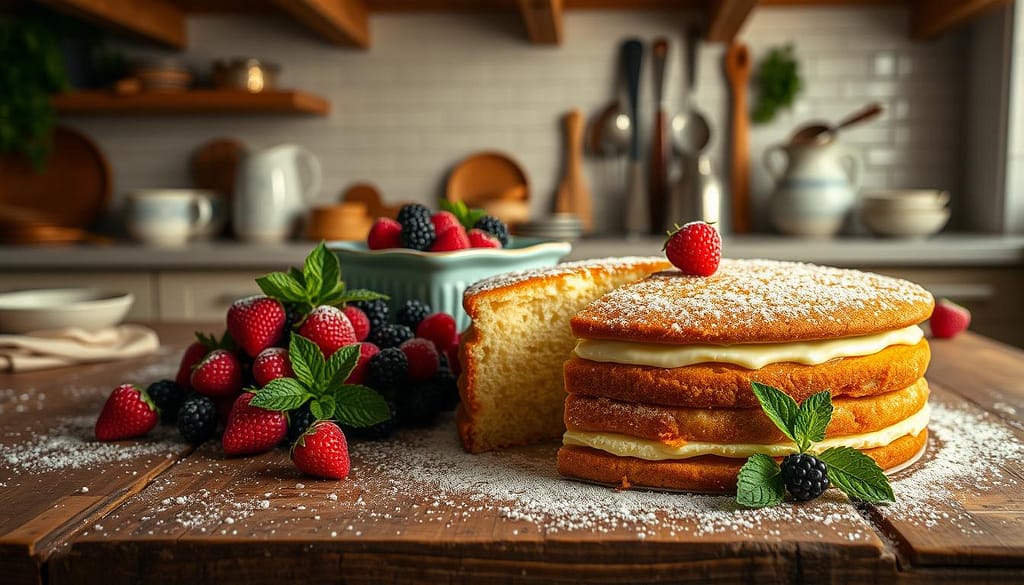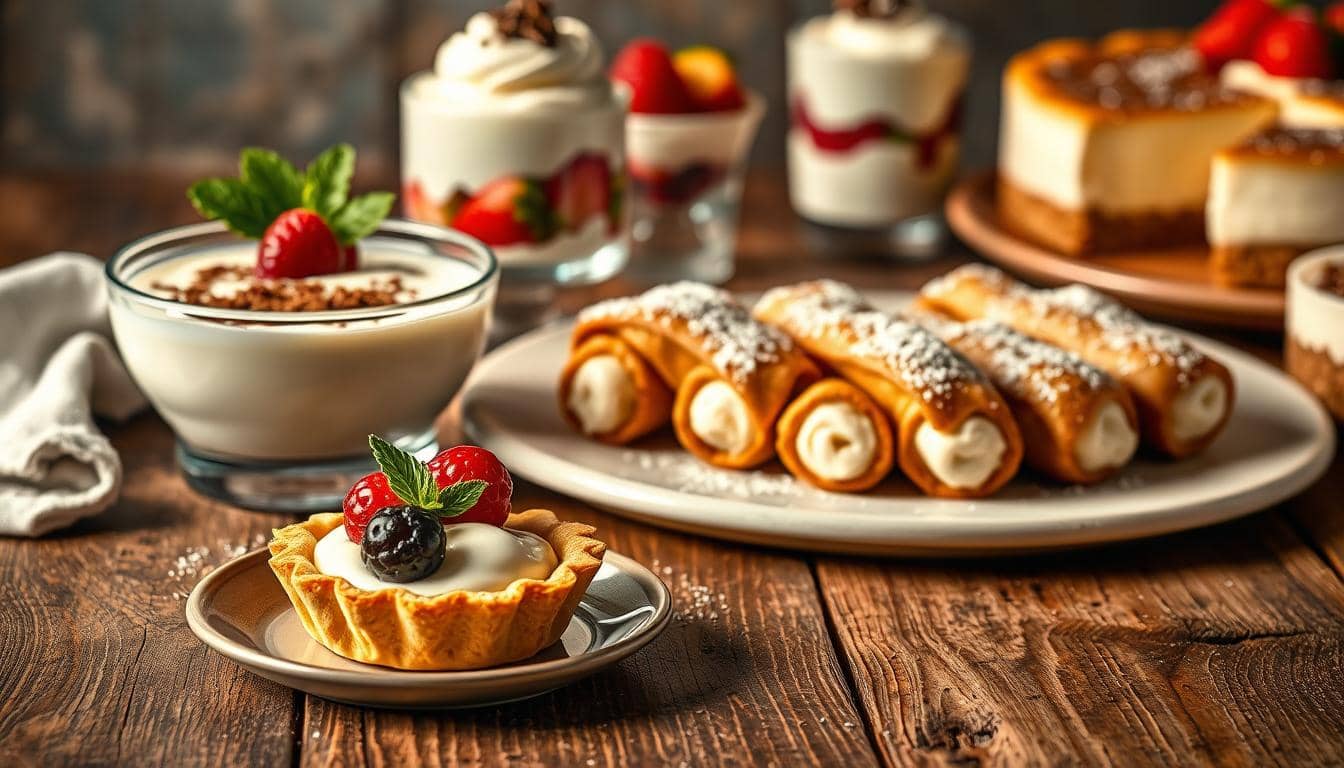Looking for creamy ricotta desserts that melt in your mouth? These easy ricotta cheese dessert recipes are here to satisfy your cravings. From no-bake treats to baked delights, ricotta’s light, silky texture makes every bite feel special. Whether you’re a kitchen pro or new to baking, these recipes keep things simple without sacrificing flavor.
Updated in March 2025, this guide highlights how ricotta’s creamy richness works magic in desserts without the heaviness of other cheeses. Perfect for gluten-free or dairy-conscious diets, these recipes adapt easily to your preferences. Dive into options like tangy lemon tarts, sweet strawberry no-bake cheesecakes, or spiced pumpkin pies—all made brighter with ricotta’s signature creaminess.
Key Takeaways
- Ricotta’s light texture makes it a star in both baked and no-bake desserts.
- These ricotta cheese dessert recipes are easy to customize for dietary needs.
- Creamy ricotta desserts pair well with seasonal fruits and warm spices.
- Updated tips ensure success whether you’re baking or making quick treats.
- Discover how ricotta adds richness without extra guilt in every bite.
Introduction to Delicious Ricotta Cheese Desserts
Looking for desserts that are both light and rich in flavor? Ricotta cheese is a great choice for baking. These ricotta cake recipes are creamy, tangy, and perfect for any event.
What Makes Ricotta Special?
Ricotta is made from whey and milk. It’s known for its airy texture and mild sweetness. Unlike heavy cheeses, it’s low in calories and fat, great for those watching their diet. It’s special because:
- It makes cakes and pastries creamy
- It’s naturally sweet, great with fruits or chocolate
- It works well in both sweet and savory dishes

Why You’ll Love These Desserts
With ricotta cake recipes, you get more than just taste. These desserts are:
- Great for dietary needs: can be vegan or gluten-free
- Easier to digest than heavy creams
- Quick to make with just a few ingredients
Chefs around the world love ricotta for making classics better. It’s perfect for simple tarts or complex desserts. Your taste buds and waistline will love it!
Benefits of Using Ricotta in Your Desserts
Ricotta cheese adds more than just taste to your desserts. It’s loved for its light, airy texture. This keeps ricotta cheesecake recipes moist but not heavy. Its mild flavor is a perfect base for creative ideas.
- Light texture: Ricotta’s low fat content creates a fluffy base for cheesecakes and tarts.
- Moisture retention: It prevents dryness, perfect for no-bake desserts.
- Flavor balance: The slight tang in ricotta cuts through sweetness, making every bite memorable.
Health-conscious cooks love ricotta for its lower calorie count. It’s also better for those with lactose sensitivity. Whether you’re making a classic cheesecake or something new, ricotta’s versatility is impressive. Try it with berries or spices to enjoy its natural creaminess. You’ll be amazed at how versatile ricotta is!
Exploring Creamy Ricotta Dessert Varieties
Ricotta tart recipes offer endless possibilities. You can choose from timeless classics or bold new twists. This mix of tradition and creativity creates unforgettable desserts.
Classic Versus Innovative Recipes
Classic ricotta tart recipes are simple yet elegant. Think of Italian classics like torta al limone or Neapolitan-style pies with citrus and sugar. These dishes show off ricotta’s natural creaminess.
But modern recipes are daring. They mix flavors like dark chocolate or lavender. Or they pair ricotta with unexpected ingredients like chili flakes.
- Classic: Lemon-ricotta tart, layered with shortcrust pastry
- Innovative: Spiced pear and ricotta galette with honey drizzle
Texture and Flavor Profiles
| Aspect | Classic | Innovative |
|---|---|---|
| Texture | Creamy filling with crisp crust | Swirls of ricotta with crunchy toppings |
| Flavor | Bright citrus or honey notes | Umami-rich combinations like black truffle or salted caramel |
| Example | Traditional Sicilian maritozzo (sweet buns with ricotta) | Molecular gastronomy-style ricotta foam with edible flowers |
Trying out ricotta tart recipes is a fun adventure. It’s a chance to mix old traditions with new ideas. Let your creativity shine, whether you’re refining a family recipe or coming up with something entirely new.
Mastering Ricotta Cake and Cheesecake Recipes
Ricotta makes cakes and cheesecakes stand out. Choose high-quality fresh ricotta for the best taste. For ricotta pie recipes, mix ricotta with eggs and flour to keep it moist. Try the raspberry ricotta cake for a tangy and sweet mix.
Key tips to remember:
- Use room-temperature ingredients for even mixing.
- Add lemon zest to enhance ricotta’s mild flavor.
- Let cheesecakes cool slowly in the oven to prevent cracking.
Avoid overmixing batters to keep them soft. Underbaking makes them soggy, so always check with a toothpick. Here’s a quick comparison:
| Aspect | Cake | Cheesecake |
|---|---|---|
| Baking Time | 25–30 minutes | 1 hour+ |
| Texture | Moist, light | Creamy, dense |
Try adding citrus glazes or fresh berries to boost flavors. Look online for ricotta pie recipes to find new ideas. With practice, you’ll create textures that impress everyone!
Step-by-Step for Perfect Ricotta Tart and Pie Recipes
Learning to make ricotta tarts and pies is all about the little things. Techniques like gentle mixing and precise timing are key. They help your desserts look and taste like they came from a bakery. These steps are also important for making ricotta cannoli recipes just right.
Ingredients and Preparation
Start with fresh, full-fat ricotta for the best creaminess. Make sure to measure flour and sugar accurately. A little mistake can change the texture. Chill the dough for 30 minutes before rolling to avoid shrinkage. This care is also essential for ricotta cannoli recipes to get the filling just right.
Baking Techniques
Preheat your oven to 350°F (175°C). Use parchment to line tart pans. Mix ingredients gently to keep air pockets in the dough. Overmixing can make the dough tough. Bake custards in a water bath for even cooking. For pies, turn pans halfway through baking to get even browning.
- Brush crusts with egg wash for golden edges.
- Let baked tarts cool fully before adding toppings to prevent sogginess.
By following these steps, your kitchen becomes a dessert lab. Whether you’re making tarts or trying out ricotta cannoli recipes, paying attention to detail makes all the difference. It turns simple ingredients into unforgettable treats.
Uncovering Unique Ricotta Cannoli and Mousse Creations
Step into the world of ricotta mousse recipes that change traditional Italian desserts. Imagine mousse with hints of citrus or chocolate. Or cannoli shells filled with ricotta mixed with crushed cookies or spices. These ricotta mousse recipes are a playground for creativity.
Start by mixing strained ricotta with whipped cream and a splash of vanilla. Add espresso powder for an affogato twist or swirl in jam for fruitiness. Serve in glasses or as layered trifles for a modern touch. The key? Let ricotta’s natural sweetness shine.
Cannoli fans can experiment too. Stuff shells with ricotta mixed with orange zest or caramelized nuts. For a gluten-free option, use almond-flour shells. Top with dark chocolate shavings or fresh berries to contrast the creamy filling. These updates keep classic desserts fresh.
Pro tip: Chill mousse thoroughly before serving to lock in that signature creaminess. Try these twists and discover how ricotta mousse recipes become your new go-to for gatherings. Let your kitchen become a lab for sweet innovation!
No-Bake and Baked Ricotta Desserts Demystified
Deciding between no-bake and baked ricotta desserts depends on your schedule and preferences. Both styles use ricotta’s creamy base but offer unique experiences. No-bake desserts save time, while baked ricotta desserts provide a cooked texture. Let’s look at how to choose the best method for your kitchen.
Time-saving No-Bake Options
These recipes are quick and easy:
- Ricotta mousse chilled with whipped cream and lemon zest
- Overnight yogurt-based parfaits with granola
- No-bake tart shells filled with fresh fruit and ricotta
Traditional Baked Recipes Revisited
For a deeper flavor, try these baked classics:
- Cheesecakes baked until edges caramelize
- Pie fillings with cinnamon-spiced baked ricotta
- Crostatas baked until golden and flaky
No-bake desserts are great for a quick treat. Baked ricotta desserts are perfect for special occasions—like warm cannoli shells with oven-roasted ricotta. Pick what suits your mood, and ricotta will surprise you.
Tips for Ensuring Creaminess in Your Desserts
Want your no-bake ricotta desserts to melt in your mouth? Here are some easy tips to avoid grainy textures. First, use fresh, high-quality ricotta. Older cheese can dry out.
For no-bake ricotta desserts, mix ingredients at room temperature to prevent clumping. Stir gently until just combined. Overmixing can make creamy mixtures lumpy.
- Temperature Control: Let cold ingredients like ricotta and cream sit at room temp for 30 minutes before blending.
- Strain Excess Liquid: Line a sieve with a clean cloth to drain ricotta, removing excess moisture for a silkier base.
- Chill Smart: For no-bake recipes, refrigerate mixtures in airtight containers to set properly without ice crystals.
“The key to smooth no-bake treats is patience—mix slowly and let ingredients rest,” says pastry chef Maria Lopez of New York’s Dolcezza Kitchen.
When adding mix-ins like fruit or chocolate, fold them in last. This prevents overworking the batter. For layering, use a spatula to gently spread each creamy layer.
Avoid using metal utensils that can create friction and heat. These steps ensure your no-bake ricotta desserts stay velvety. You can make tarts, mousse, or dips.
Incorporating Seasonal Ingredients in Ricotta Desserts
Let the seasons inspire your ricotta creations. Seasonal ingredients add flavor and color to your desserts. Here’s how to match them perfectly.
“Nature’s bounty changes with the weather—so should your recipes!”
Fresh Produce Pairings
Pair ricotta with what’s in season for bold flavors:
- Summer: Berries, melon, or grilled peaches
- Fall: Pears, apples, or spiced squash
- Winter: Blood oranges, cranberries, or pomegranate
- Spring: Rhubarb, strawberries, or lemon zest
Seasonal Flavor Boosts
Seasonal picks cut added sugars and boost natural taste. Try:
- Winter: Orange segments in cheesecake layers
- Autumn: Cinnamon-spiced apple compote with ricotta pancakes
- Spring: Zested lemon in mousse bases
Visit local markets for peak-ripe fruits. Your desserts will taste fresher and brighter. Experiment with seasonal pairings to keep your recipes ever-changing!
Creative Twists on Classic Ricotta Recipes
Do you love ricotta desserts but want something new? Try these fun upgrades to timeless recipes. From bold flavors to clever presentation ideas, these twists add excitement without losing the cheese’s creamy base.
- Add bitter dark chocolate shavings to ricotta cheesecake for a bittersweet contrast.
- Swap vanilla with blood orange zest in cannoli filling for a zesty surprise.
- Layer ricotta mousse with spiced pear slices for a warm autumn dessert.
Compare classic and modern versions:
| Classic | Creative Twist |
|---|---|
| Plain ricotta tart | Matcha-infused crust + pomegranate seeds |
| Tiramisu | Coffee-infused ricotta + gold leaf garnish |
| Ricotta pancakes | Blueberry swirl + lemon glaze |
Play with textures too! Mix in candied ginger or crushed nuts for crunch. Use edible flowers or dark chocolate drizzle to dress up plates. Let your creativity shine—there’s no wrong way to innovate!
How to Customize Your Ricotta Cheese Dessert Recipes
Make any recipe your own. Change the sweetness, add your favorite ingredients, or adjust the texture. Here’s how to make every bite special.
Personalizing Flavors
Try these easy swaps to add depth:
- Swap vanilla extract for orange zest or almond extract
- Blend in spices like nutmeg or cocoa powder
- Top with fresh fruit, nuts, or dark chocolate
Adapting Recipes for Dietary Needs
Make changes for your diet:
| Need | Substitute | Example |
|---|---|---|
| Vegan | Plant-based milk/yogurt | Coconut milk instead of dairy cream |
| Gluten-free | Almond flour or rice flour | Swap regular flour for gluten-free blends |
| Low-sugar | Monk fruit or erythritol | Cut sugar by ⅓ and add vanilla syrup |
Pro tip: Taste as you go—start with small changes and adjust gradually. Let your creativity guide you while keeping ricotta’s creamy base intact.
Balancing Flavor and Texture in Creamy Ricotta Delights
Every bite of ricotta desserts is special when flavors and textures come together. If it’s too tangy, add honey or fruit. For too much creaminess, try toasted nuts or cookie crumbs. The goal is to blend everything so nothing stands out too much.
- Sweet and tangy: Mix lemon zest with chocolate chips for a nice contrast.
- Textural layers: Add fresh berries or whipped cream on top of cheesecakes for a creamy and crisp mix.
- Test as you go: Taste your mixtures before baking to tweak sweetness or acidity.
Begin with creamy ricotta and then add more. Vanilla extract brings warmth, while cinnamon adds depth. If it feels too much, stick to 2-3 main flavors. Crunchy toppings like granola or flaky salt add texture without hiding the ricotta’s mild taste.
Getting the balance right isn’t random. Use specific ratios: 1 tbsp lemon juice per cup of ricotta, or ¼ cup mix-ins per batch. Letting the flavors meld by chilling the mixtures for 30 minutes before serving helps. This allows tastes to blend and textures to settle.
The Future of Ricotta Dessert Trends
Chefs and home bakers are mixing old traditions with new ideas. They’re creating the next big thing in ricotta desserts. Modern cooking is all about combining science and creativity in new ways.
Emerging Techniques
- Sous vide methods for silky textures
- Plant-based ricotta alternatives using almond milk or coconut cream
- Nano-bonding techniques to stabilize flavors
“The future is about respecting ricotta’s roots while playing with form and function,” says Chef Elena Marquez of NYC’s La Dolce Vita.
Innovative Presentations
Creative plating now includes:
- Edible “soil” made from cocoa nibs and crushed nuts
- Frozen spheres of infused ricotta using liquid nitrogen
- 3D-printed chocolate garnishes
| Trend | Example |
|---|---|
| Temperature contrasts | Cold panna cotta with warm honey drizzle |
| Color layering | Rainbow-hued ricotta mousse layers |
Stores like Whole Foods now stock flavor-infused ricotta for DIY creations. Follow these trends to stay ahead while keeping recipes rooted in authenticity.
Conclusion
Ricotta cheese is a creamy base for desserts that are both simple and indulgent. Its mild flavor works well with fruits, spices, and sweeteners. This makes it a star in no-bake treats and baked cakes.
Whether you’re making a classic tart or trying new twists, ricotta’s versatility shines. It’s perfect for any dessert lover.
Now it’s time to make these recipes come to life! Pick your favorite method—no-bake for quick fun or baked for rich results. Let your creativity guide you.
Add seasonal berries, chocolate, or nuts to match your taste. Don’t forget to share your creations online. Tag #RicottaDessertLovers to join a community of home bakers and taste-testers.
Every bite of ricotta-based dessert is a chance to enjoy something fresh and customizable. With these recipes, you can make desserts that impress friends and family. Happy baking!
Don’t hesitate to tweak ingredients to suit your diet or mood. The best part? There’s always room for more experimentation next time.

